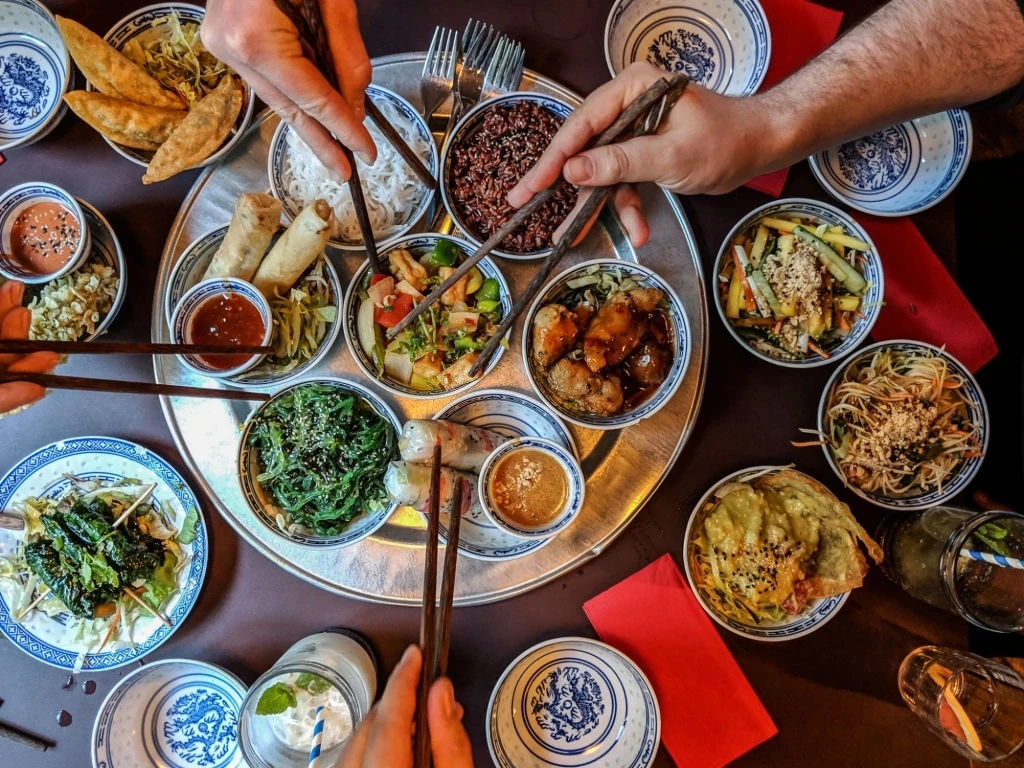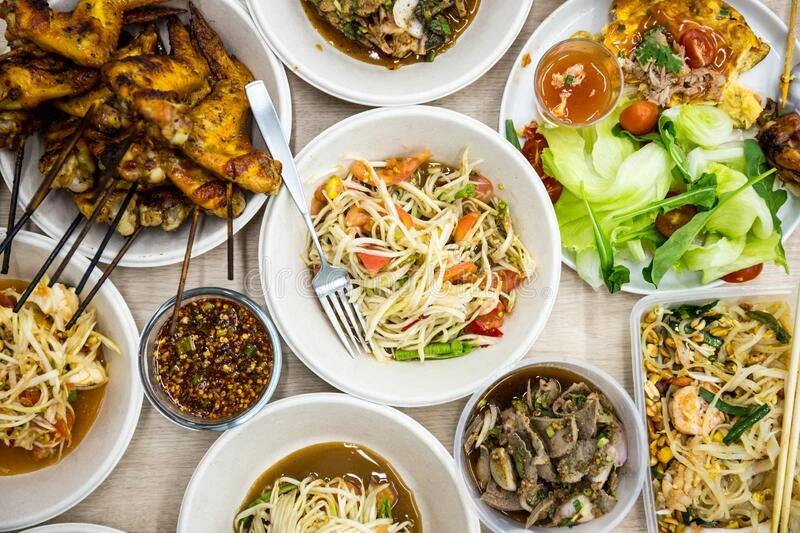
1
Thai Essence
The Essence of Thai Cuisine: A Culinary Journey
At our establishment, we take great pride in delivering the true essence of Thai cuisine to our guests. Thai food is renowned for its intricate balance of flavors, fresh ingredients, and aromatic herbs and spices. In this blog, we'll take you on a culinary journey through the vibrant world of Thai cuisine, exploring its history, key ingredients, signature dishes, and what makes it so beloved by food enthusiasts around the globe.
A Brief History of Thai Cuisine
Thai cuisine is a melting pot of cultural influences and regional variations, reflecting the diverse landscape and rich history of Thailand. It has been shaped by neighboring countries, trade routes, and royal traditions. Key influences come from China, India, Malaysia, and Portugal, each leaving an indelible mark on the culinary practices of Thailand.
Thai cuisine traditionally revolves around five fundamental taste senses: sweet, sour, salty, bitter, and spicy. This balance is the cornerstone of Thai cooking, where dishes are carefully crafted to offer a harmonious blend of these flavors.
Key Ingredients in Thai Cooking
The essence of Thai cuisine lies in its fresh, aromatic ingredients. Here are some of the staples that define Thai cooking:
- Herbs and Spices: Thai cooking extensively uses herbs like lemongrass, kaffir lime leaves, Thai basil, and galangal. These ingredients contribute to the aromatic and vibrant nature of Thai dishes.
- Chilies: Both fresh and dried chilies are used to add heat to Thai dishes. The level of spiciness can vary, but a little heat is essential to bring out the other flavors.
- Fish Sauce: A key ingredient in Thai cuisine, fish sauce adds a deep umami flavor to dishes. It's often used in marinades, dressings, and as a seasoning.
- Coconut Milk: This creamy, slightly sweet ingredient is a base for many Thai curries and soups, adding richness and depth to the dishes.
- Rice and Noodles: Rice, especially jasmine rice, is a staple in Thai cuisine. Sticky rice is also popular in the north and northeast. Various types of noodles, such as rice noodles and egg noodles, are used in stir-fries and soups.
- Fresh Vegetables and Fruits: Thai cuisine utilizes a wide variety of fresh vegetables and fruits, such as green papaya, mango, and tamarind, adding unique textures and flavors to the dishes.
Signature Thai Dishes
Thai cuisine offers a diverse array of dishes, each with its own unique flavor profile. Here are some signature dishes that capture the essence of Thai cooking:
Tom Yum Goong (Spicy Shrimp Soup)
Tom Yum Goong is a quintessential Thai soup known for its bold flavors and aromatic ingredients. It combines shrimp, lemongrass, kaffir lime leaves, galangal, and chilies in a clear broth flavored with fish sauce and lime juice. The result is a spicy, sour, and savory soup that awakens the taste buds.
Pad Thai (Stir-Fried Noodles)
Pad Thai is perhaps the most well-known Thai dish outside of Thailand. This stir-fried noodle dish includes rice noodles, eggs, tofu or shrimp, bean sprouts, and a tangy sauce made from tamarind paste, fish sauce, and palm sugar. It is garnished with crushed peanuts, lime wedges, and fresh herbs. The combination of sweet, sour, and salty flavors makes Pad Thai a favorite among diners.
Green Curry (Gaeng Keow Wan)
Green curry is a rich and flavorful dish made with green curry paste, coconut milk, and a variety of vegetables and proteins, such as chicken or tofu. The paste, which includes green chilies, garlic, lemongrass, and Thai basil, gives the curry its vibrant color and distinctive taste. Served with jasmine rice, green curry is a perfect example of the balance of flavors in Thai cuisine.
Som Tum (Green Papaya Salad)
Som Tum is a refreshing and spicy salad made from shredded green papaya, tomatoes, chilies, garlic, lime juice, fish sauce, and palm sugar. It is often topped with peanuts and dried shrimp. The crunchiness of the papaya, combined with the tangy, spicy dressing, makes Som Tum a popular dish, especially in the hot Thai climate.
Massaman Curry
Massaman curry is a rich and creamy dish with Persian influences, featuring a blend of spices like cinnamon, cardamom, and cloves. It is made with coconut milk, potatoes, peanuts, and meat (commonly beef or chicken). The sweet and savory flavors, combined with the aromatic spices, make Massaman curry a beloved comfort food.
The Importance of Balance in Thai Cuisine
One of the defining characteristics of Thai cuisine is the meticulous balance of flavors. Each dish aims to achieve harmony among the five taste senses, creating a complex yet satisfying culinary experience. This balance is not only crucial for the flavor but also for the nutritional benefits, as Thai food often incorporates a variety of fresh, wholesome ingredients.
Cooking Techniques in Thai Cuisine
Thai cooking techniques are as diverse as the ingredients themselves. Some common methods include:
- Stir-Frying: This quick-cooking method retains the freshness and crunch of vegetables while infusing the dish with the flavors of the sauces and spices.
- Grilling: Many Thai dishes, such as satay and grilled fish, are cooked over an open flame, adding a smoky, charred flavor.
- Steaming: Steaming is used for a variety of dishes, including fish and dumplings, preserving the natural flavors and nutrients.
- Simmering: Curries and soups are often simmered slowly to allow the flavors to meld and develop.
- Pounding: Ingredients like chilies, garlic, and herbs are often pounded in a mortar and pestle to release their full flavor potential.
The Role of Thai Street Food
Street food plays a significant role in Thai culinary culture. It offers a wide variety of dishes, from snacks to full meals, at affordable prices. The vibrant street food scene allows people to experience the true essence of Thai cuisine, with vendors specializing in specific dishes perfected over generations.
Bringing Thai Cuisine Home
For those inspired to bring the flavors of Thailand into their own kitchens, starting with simple dishes like Pad Thai or Tom Yum Goong can be a great introduction. Many ingredients can be found at local Asian markets or online, and experimenting with different herbs and spices can help you achieve the authentic taste of Thai cuisine.
Conclusion
The essence of Thai cuisine lies in its ability to harmonize diverse flavors and fresh ingredients into dishes that are both complex and comforting. By understanding the history, key ingredients, and signature dishes, one can truly appreciate the artistry and passion that goes into Thai cooking. Whether you’re enjoying a meal at a bustling street food market or recreating these dishes at home, the vibrant and aromatic world of Thai cuisine is sure to delight your senses and leave you craving more.


